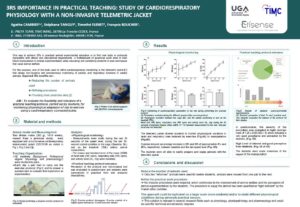Agathe CAMBIER1,2, Stéphane TANGUY1, Timothé FLENET2, François BOUCHER2
¹ PRETA TEAM, TIMC IMAG, 38706 La Tronche CEDEX, France
² R&D, ETISENSE SAS, 60 avenue Rockefeller, 69008 LYON, France
15th FELASA Congress, 2022
Abstract
A 3R approach is essential when thinking of maintaining practical experimental education on laboratory animals at university, especially for integrative physiology teaching.
This work gives an example of this approach with a study aiming at evaluating the implementation of a practical experiment on physiological adaptation to controlled exercise, using a cardiorespiratory connected jacket for small mammals and a treadmill.
Two males wistar rats (360 gr, 14/16 weeks, reused from a previous study) were accustomed to the jacket and the treadmill. Twelve students from a professional “physiology and pharmacology” bachelor degree were divided in pairs. For two weeks, each pair was daily asked to equip the animals with the jacket and carry out a standardized exercise protocol. They finally answered a questionnaire to assess their experience as experimenter.
Although only two animals were used during the sessions, all the students got the opportunity to equip and study freely moving animals. The telemetric jacket allowed them to record the expected increases of heart and respiratory rate at the different imposed running speeds. In the questionnaires, the severity of the procedure was evaluated to light (average mark of 1.25± 0.09(SD)/5 (0-light, 5-severe)) which indicated a very good acceptance and perception by the students.
To conclude, the study of cardiorespiratory physiology using non-invasive monitoring jacket allowed to reduce the number of animals used and refine the practical work procedure. This approach could be replicated on a larger scale (more students) or to study different physiological conditions during university courses.

